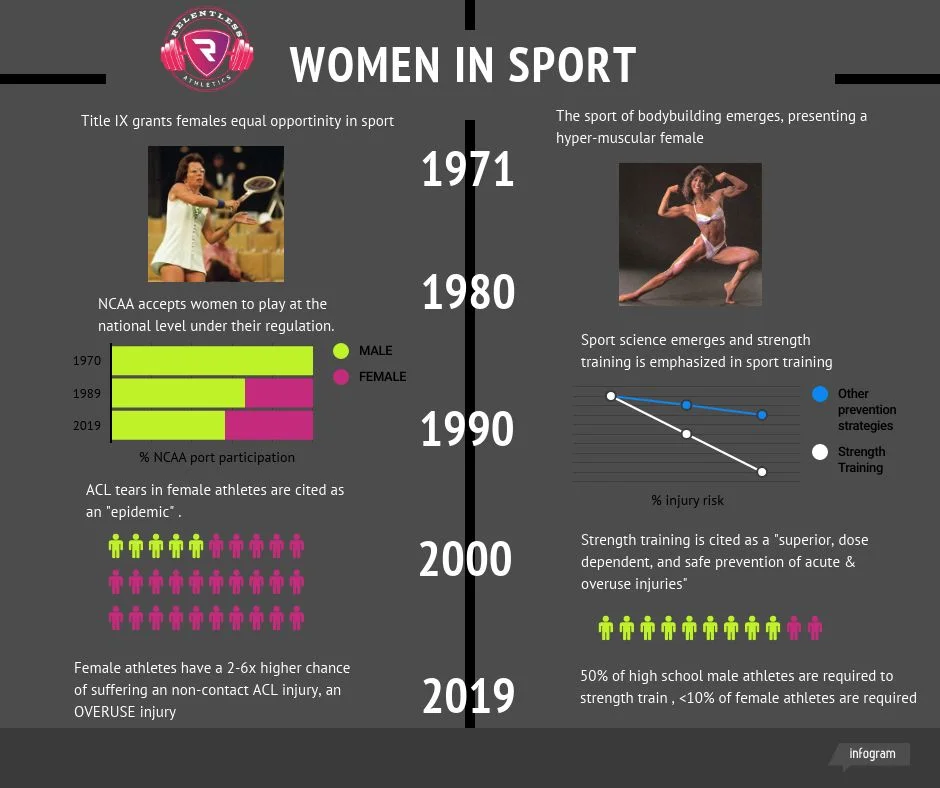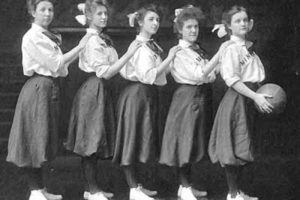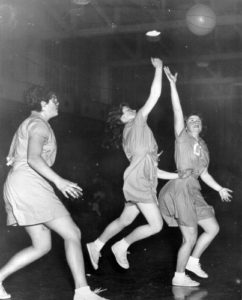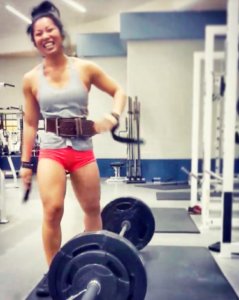THE PARADOX of FEMALE and ATHLETE.
Emily R Pappas, MS
Let play a quick game…when we say “girls in the weight room”, what comes to mind?
Do you think:
Props to world arm-wrestling champion Nataliya Kuznetsova (above)…
….but back to reality for a minute.
Downing anabolic steroids and achieving 20” biceps isn’t the norm.
So why do we think it is? And, since it’s not, why do extreme examples like the one above keep us sports babes from touching the free weights?
Maybe…centuries of history filled with bias and bad science???
Ok, so it’s no real surprise when we say: women in sports are up against hundreds of years of ‘science’ founded in the mythology of female fragility. We face all the normal challenges of athletic performance, AND on top of it, we’ve been told…
Heavy lifts will make you “huge”
Compete hard, but not too hard…you don’t want to be too manly!
Strong is beautiful… but too strong? Gross. Not feminine at all.
We’ve heard it from well-meaning friends, parents, coaches, and trainers. Even our teammates fill us with self-doubt.
We face this Female Athlete Paradox: Do I do my best or am I compromising who I am as a woman?
The truth is, this paradox is leftover from a long history of outdated cultural norms. Modern science shows the female body isn’t as fragile as society once thought. Today, women everywhere continue to DEFY and REDEFINE these norms by setting records and astounding sports fans.
It’s time we talk about it: where our skepticism comes from, and how it’s keeping us from performing our best.
Let’s hop in the way-back machine to look at how the history of the female athlete still lingers in the field today.
Early 1900s: Goals Are Nice…But First- BABIES.
There’s nothing better than a sweltering summer day on the links in a modest wool jacket!
Before the 1970s, women’s sports had an entirely different function than men’s.
Take, for instance, how school programs approached men’s vs. women’s sports.
From the 1860s until the 1970s, male sports were supervised by COACHES who emphasized competitive play. Winning vs. losing…beating the other team.
But women’s sports? Female sports were supervised by “physical educators (2) with an emphasis intentionally placed AWAY from competitiveness. Instead, the purpose of sport was to acquire skill.
This wasn’t done by malicious intent.
Rather, it reflected the priorities society placed on the purpose of being a woman. Women were the ‘fairer sex’ and above all had to protect their health…ESPECIALLY their reproductive health.
Careful, ladies! Don’t let those free throws steal the blood from your uterus!
Up until the 1940s, physicians believed strenuous exercise was DANGEROUS for women.
It was widely believed humans only had a certain amount of energy capacity. Naturally, if females spent their energy in the vigorous activity of sport, they would have less available for reproduction.
Scientific authorities also claimed menstruation put excessive stress on the human body as it “robbed the brain and other organs of blood”(2).
When wrapped together, these misguided beliefs lead to the thinking that women who participated in sports, especially during menses, risked catastrophic damage to their long-term reproductive health (9).
This concept of limited energy was so widely believed that, when combined with the intellectual demands of schooling, women were told they risked sterility if they participated in sports at the same time.
Because of this…competitive sports were simply unavailable to girls.
Mid 1900s: Are We REALLY So Fragile?
Now, “Female Fragility” is the LAST thing on your mind when you’re slammed to the ground during tournament play.
In the heat of the game, none of us are stopping to weigh the risks of making babies vs. incepting a goal…and we owe that to the female educators who started to question female fragility in the early 20th century.
As women themselves, educators knew this concept of fragility didn’t line up with how they actually felt. They began to support the expansion of school sports and encourage women to engage in more physical activity.
It wasn’t a perfect fix, but it was a step in the right direction. A LOT of misinformation about women’s reproductive health still affected the way we could participate in sports. Rules prohibiting strenuous activity and competitive sport during menstruation were highly enforced.
For example: in 1931 at Smith College in Massachusetts, female undergraduates were not allowed to ride a horse or engage in swimming during their menstrual cycle. This rule was enforced up until the mid-1970s!!!
Restraints also LIMITED the extent of competitive play females were allowed to engage in.
In 1931 the women’s gymnasium at the University of Texas at Austin was created with specific elements to help make sport “suitable” for women. Authorities feared large spectator crowds would cheer women into overexertion. So, by design, sideline space was limited to prevent the installation of large bleachers.
In today’s world, this sounds crazy. But in the 1930s? Building a gymnasium to encourage women to participate in sports was a huge step towards athletic equality.
Through the mid-1900s, women’s sports were not only subjected to unequal environments but also governed by additional rules than men’s sports.
In women’s basketball, for example, initial rules were established that limited the amount of space the athlete was allowed to occupy as well as a limitation of the number of dribbles allowed per possession.
Meanwhile, the male version of the game allowed the athletes to roam freely throughout the court with unlimited dribbling per possession.
Can you imagine having to COUNT the number of dribbles you had available while on the court???
These types of rules created a perception that is was OK for women to be athletic, just not to the same extent as men.
By the way, it wasn’t until 1966 that the women’s version of the game was changed to allow for unlimited dribbling. (16)
Crazy, right?
All this created the underlying doubt female athletes still face today: That femininity and physicality might not be compatible.
Late 1900s: Babes And Barbells
“Do you even lift, BRO?”
The idea that a woman compromises her femininity when she reaches for a physical achievement is 100% INCOMPATIBLE with modern women’s rights and cultural norms.
But that doesn’t stop us all from being a little judge-y when it comes to female athletic bodies.
Instagram fitness gurus aren’t helping. Just when we should be concentrating on our PRs, we’re held back wondering if we look too-muscley in a bikini.
This thinking is TOTALLY outdated.
Where does this “the way you look” vs. “the way you perform” question come from?
It comes from physical educators of the 20th century through their inclusion of “Phys Ed-iquette” as a major focus of the curriculum (74) What was this? Well, during this time the physical characteristics associated with sport, like as aggression, discipline, teamwork, and self-sacrifice were typically associated with masculinity.
Since sports developed these qualities, the extent to which females were allowed to engage in sport had to be limited in order to limit the development of these qualities (and therefore the loss of femininity). (74)
Even Olympic officials were once unsure of the suitability of women’s participation in sport.
International Olympic committee member Karl Ritter von Halt suggested to “…do away with women’s athletic championships” as he felt that men “were born to compete, [and that] competition is alien to women’s nature.”
Change was slow.
As physicians’ stance on females and strenuous activity began to shift in the early 1930s, female participation grew and the number of female events in the Olympics slowly increased.
But female athletes began to EXCEL at this level internationally, sports authorities began to question if such athletes were actually women.
In today’s world, this is not just stereotypical…but sexist. Being a man and NOT playing a sport doesn’t make you less than a man. So why would being an athletic woman make you less of a woman?
With this concern, certain hormonal tests were enforced ONLY on women and a “certificate of femininity” is required at times to prove their sexuality. This practice STILL exists in “verifying” women who are thought to perform “too well” to actually be women.
1998, Veronica Brenner: The Canadian skier’s “femininity card” which certifies her XX chromosomes
It wasn’t until Veronica Brenner arrived at the 1998 Nagano Olympic Games that she was told she would need to pass a sex test before competing. According to the New York Times:
“I said: ‘Are you kidding?’ I’d been competing my whole life, and my gender has never been questioned!” Brenner’s test confirmed that she had XX chromosomes, and she was given what was commonly called a “femininity card” to prove she was the gender she claimed to be.
But she was irked that despite the many advances of female athletes in the last half-century, powerful male athletes are celebrated and powerful female ones are suspect. “We’d hear comments all the time: ‘She’s really strong — she must be part guy.’ ”
Meanwhile, collegiate sports has experienced an equally slow change of heart. Take 1960: With the intention of closing the chasm on the medal stand, the US worked with physical educators to promote the development of female athletes. They launched a branch of National Institutes to train physical educators to teach advanced sports skills to their athletes (10).
By 1971 the Association for Intercollegiate Athletics for Women (AIAW) was established to administer a program of national championships in women’s college sport and scholarships to female athletes.
Up until 1981, the NCAA resisted expanding women’s sports in the collegiate system fearing the additional programs would divert money away from successful male sports (65).
Yep, not until 1981 did the NCAA offer women’s championships.
With this expansion, by 1982 AIAW ceased operations as many universities were swayed by the convenience of one governing organization for both their male and female sports.
1981 WAS NOT THAT LONG AGO!!!
When the governing authorities of the oldest and most respected sports associations spread the propaganda that “men who excel in sports are normal…while women are not”…how can we, as female athletes, be expected to defy these norms?
STRONG women...Strong WOMEN.
How does history lead us to the weight room?
Prior to the 1960s, most coaches believed lifting weights would make athletes muscle-bound, limiting athletic performance (8).
By the 1970s, this myth started to fade. The strength and conditioning experienced rapid growth as high-performing athletes looked for a competitive edge.
That being said, this industry boomed for MALE athletes and left women behind.
Title IX helped the number of female athletes increase 6x in collegiate level and 4x in the high school level…but not many girls made it to the weight room.
There is a big gap between mandatory weight training requirements in men’s sports…and the lack thereof in women’s. Studies show female athletes who participate in strength training to enhance sports performance are rare to find. One study on interscholastic athletes puts this gap of athletes required to lift for high school sports at 50% of male VS. 9% of females (6).
Even in the NCAA IIl level, there exists a large disparity of strength training requirements between male and female athletes (5).
At Relentless, we’ve sent female athletes to Division I, II, and III. I can tell you there is a HUGE difference between the type of strength training provided for the females compared to males AT ANY LEVEL.
There are AMAZING programs out there but it is still so disheartening to find the level of inequality between male and female programs at the Division I level.
Female athletes- who are receiving SCHOLARSHIPS for their athletic performance!- are not receiving a TOOL that is WIDELY ACCEPTED in the male sports culture as being NECESSARY for improved performance and reducing injury risks.
So why the heck are females not receiving the same push to enter the weight room as males?
Girls In The Weight Room.
Male athletes hit the weight room to increase performance and prevent injury. It’s now considered standard practice.
But you just don’t find women in the weight room because strength training is STILL considered masculine.
This association between strength training and hyper-muscularity comes from the rise of females and bodybuilding in the 1980s (4). But this “ultra muscled look” doesn’t happen the moment a girl picks up a dumbbell. It happens through a purposeful regimen designed to give someone that bulked-up look through YEARS of intense training and usually with a regime of steroids.
When the general public can’t tell the difference between bodybuilding and strength training for sport…the weight room has gotten a bad rep for girls.
We NEED strength training to improve not just strength, but also body awareness, coordination, and power. But strength-training for women is rarely enforced (1).
The result? A dramatic rise in injuries.
Particularly ACL injuries.
Since the early 1980s, knee injuries in female athletes have risen to alarming rates. Those who study this even go so far as to describe this as an epidemic or plague (7). These injuries are rising in women faster than men (up to 8x more in frequency) AND this rise in rates has no relation to SPORT TYPE but rather GENDER.
This rise coincides with the expansion of women’s championship (and therefore high-level female sport) under the NCAA umbrella. With this expansion, more females are participating in HIGH levels of competitive sport….yet are NOT given the same level of preparation as men.
Sports In The Media
For the last 50 years, American commercial culture has evolved to celebrate athletic women. Athletics and women have been used to boost commercial sales on everything from Motrin and chewing gum (3).
Although this exposure is VITAL in spreading acceptance, the way women are depicted continues to perpetuate the concept of “femininity”. Athletic females are expected to not only excel on the field, but to function as beauty or sex icons for the public.
The acceptable athletic woman is one who was “firm but shapely, fit but sexy, strong but thin”. Those who don’t fit this mold are met with harsh criticism, often characterized as being masculine or accused of being on drugs (3).
Would this advertisement read the same if it featured a man?
Women showing heightened levels of strength are seen as somehow inappropriate…a contrast to the cultural norms of femininity established waaaay back in the 1800s.
Because we’re afraid of not being accepted, many of us shy away from resistance training programs. We’ve been misled by the fears that lifting would make us look muscular or bulky.
The paradox of this fear is this: High-performance REQUIRES a certain level of musculature. Otherwise, we are putting ourselves as a HUGE risk of injury.
Here’s the real truth:
When you choose to skip the weight room, you LIMIT your performance and expose your body to higher risks (2).
This Is The PARADOX Of The FEMALE And The ATHLETE
In the past, women were restricted because we were thought to be biologically incapable…too fragile to engage in strenuous activity
Slowly, real science began to change society. With the passage of Title IX in 1971, more women have participated in sports.
Despite this fact, females aren’t required to engage in strength training to the same extent of their male counterparts.
Women are taught to view strength training as a masculine activity rather than an athletic one.
It’s no wonder we stray from the weight room.
We constantly hear of athletes “holding back” in their collegiate weight training programs or performing extra cardiovascular work (without their coaches’ knowledge) in order to avoid getting bulky.
These actions are a DIRECT RESULT of the contradicting information we hear from our coaches, friends, and family…and the LACK of information regarding the necessity of strength training for ATHLETES (regardless of gender).
Our duty is clear. We MUST EDUCATE ourselves and reposition female athletes to view strength training NOT as a primary means to gain muscle mass and bulk, but as a way to improve ATHLETICISM.
For female athletes, strength training develops the ATHLETIC BASE from which sport-specific skills are derived. ON average, most females who engage in strength training and proper nutrition tactics will gain MAYBE 1-2lbs of muscle per year.
That doesn’t sound too bulky to us…..
Strength training has massive benefits for athletic performance. Studies show:
Improved body awareness
Increased coordination
Higher POWER OUTPUTS
Faster speeds
DECREASED RISK OF INJURY (remember sport is stressful, and strength training helps your muscles, tendons, ligaments, and bones handle these high levels of stress!)
Rather than building bulk, it is the duty of Coaches, the NSCA and the NCAA to provide EDUCATION for our athletes (and parents) on the necessities of strength training.
Strength training is an essential TOOL for athletic development and long term health, regardless of gender.
BULK does not happen on accident. And neither does athletic success.
When we, as women, participate in sports without giving ourselves the solid foundation of strength training, we only limit ourselves.
There’s no doubt we have a long way to go in the fight for equality in sports. But let’s remember what’s at the heart of this for us:
We have an opportunity that women have fought for for 200+ years.
We can showcase our abilities, our skills AND OUR STRENGTH. Proving that all bodies are beautiful… Every time you walk into the weightroom, you’re not just doing something that will make you a better athlete. You are defining and REDEFINING two centuries of misguided cultural norms.
Yes, this is about preventing injury.
Performing better.
Winning games and winning scholarships.
But, most of all, this is about YOU setting the record straight for the next generation of women’s sports.
Lifting doesn’t make you bulky. Lifting makes you an athlete.
REFERENCES:
Abe T, DeHoyos DV, Pollock ML, and Garzarella L. Time course for strength and muscle thickness changes following upper and lower body resistance training in men and women. Eur J Appl Physiol 81: 174-180, 2000.
Dworkin, SL. “Holding back”: Negotiating a glass ceiling on women’s muscular strength. Sociol Perspect 44: 333-350, 2001.
Heywood L, and Dworkin SL. Built to win: The female athlete as cultural icon. Minneapolis, MN: U MN Press, xxi, 2003
McGrath SA, and Chananie-Hill RA. Big freaky-looking women: Normalizing gender transgression through bodybuilding. Sociol Sport J 26: 235–254, 2009
Poiss CG, Sullivan PA, Paup DC, and Westerman BJ. Perceived importance of weight training to selected NCAA Division III men and women student athletes. J Strength Cond Res 18: 108-114, 2004
Reynolds ML, Ransdell LB, Lucas SM, Petlichkoff LM, and Gao Y. An examination of current practices and gender differences in strength and conditioning in a sample of varsity high school athletic programs. J Strength Cond Res 26: 174-183, 2012.
Theberge, N. The Gendering of Sports Injury: A Look at the “Progress” in Women's Sport through a Case Study of the Biomedical Discourse on the Injured Athletic Body”. Sport in Society 9: 634-649, 2006.
Todd TC. The myth of the muscle-bound lifter. Strength Cond J 7: 37-41, 1981
Vertinsky PA. Exercise, physical capability, and the eternally wounded woman in late nineteenth century North America. J Sport Hist 14: 7-27, 1987.
Wushanley Y. Playing Nice and Losing: The Struggle for Control of Women’s Intercollegiate Athletics, 1960-2000. Syracuse, NY: Syracuse UP, 62-75, 126-141, 2004.


















